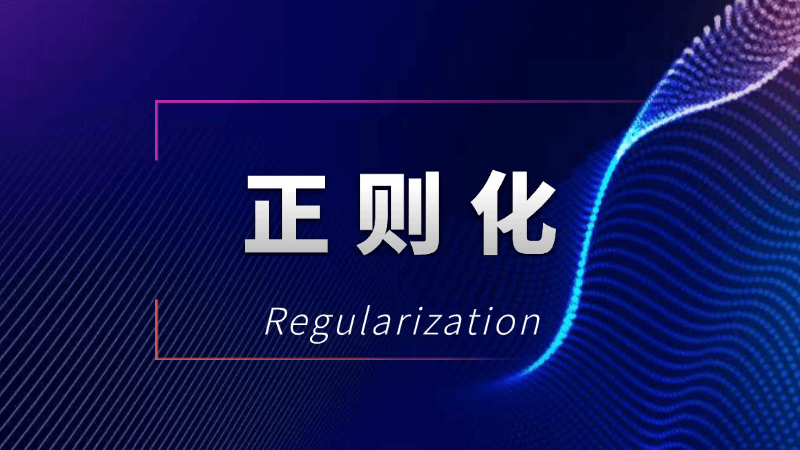Regularization (Regularization) is what, an article to see and understand
Definition of regularization
Regularization is a core technique in machine learning and statistics to prevent model overfitting. Overfitting means that the model performs well on training data but degrades on new data. Regularization controls the degree of fit by adding a penalty term to the objective function that is related to the complexity of the model. Common forms include L1 and L2 regularization: the L1 produces sparse solutions and is suitable for feature selection; the L2 shrinks the coefficients uniformly and improves stability. The technique is essentially a concrete implementation of the bias-variance trade-off, which reduces variance and improves generalization error by introducing a slight bias. The regularization parameters are determined by cross-validation, and the idea fits the Occam's razor principle - simple models are preferable. From a Bayesian perspective, regularization corresponds to the prior distribution, incorporating domain knowledge into the model estimation. As a fundamental tool for machine learning, regularization improves model robustness and utility through mathematical constraints.

Origins of regularization
- History Rooted in Mathematical Optimization: The concept of regularization first appeared in the 1940s as Tikhonov regularization for solving ill-posed problems, such as numerical instability in inverse problems. Tikhonov, a Russian mathematician, proposed to obtain a unique solution by adding a stabilizing term. This work laid the foundation for the subsequent theory of regularization, which influenced the field of computational mathematics for decades.Tikhonov regularization was initially developed for partial differential equations, but was later generalized to a wider range of optimization problems.
- Developments in statistics: In the 1970s, statisticians Hoerl and Kennard introduced Ridge Regression, the L2 regularized linear model, for dealing with multicollinearity problems. It marked the entry of regularization into the mainstream of statistics. Ridge regression improved estimation stability by penalizing coefficient magnitude and became a standard tool in econometrics. During the same period, other statistical methods such as principal component regression also incorporated the idea of regularization.
- Adoption in the field of machine learning: Support Vector Machines (SVMs) emerged in the 1990s and regularization became a central component. scholars such as Vapnik combined structural risk minimization with regularization, emphasizing model complexity control. The regularization term in support vector machines ensures that the classification interval is maximized and improves the generalization ability. At this stage, regularization moves from theory to practice and is applied to pattern recognition tasks.
- Evolution in neural networks: At the beginning of the 21st century, in the deep learning revolution, regularization techniques such as Dropout and weight decay were widely adopted to solve the problem of neural network overfitting.Researchers such as Hinton pushed for its practical application.Dropout reduces overfitting by randomly dropping neurons, simulating model averaging. Regularization became a necessary component for training in deep networks.
- Modern Extension: In recent years, regularization ideas have been extended to the fields of adversarial training and data augmentation, forming diverse methods to adapt to the big data environment. Adversarial regularization improves robustness by adding perturbation samples, and data augmentation regularization expands the dataset using transformations. These extensions show the continuous evolution of regularization techniques to address emerging challenges.
Core Principles of Regularization
- Equilibrium fitting and generalization: Regularization at its core is a trade-off between the model's accuracy on training data (fitting) and its predictive power on new data (generalization). Adding a penalty term prevents the model from overfitting to the training noise. This principle is based on an empirical risk minimization framework, where the regularization term acts as a complexity penalty, guiding the model to choose simpler assumptions. The equilibrium is evaluated by a validation set to ensure that the model is not overly complex or simple.
- Bias-variance trade-off: Reduce the variance (sensitivity to data fluctuations) by increasing the model bias (simplifying the model), thus reducing the total error. This principle is based on statistical learning theory, where bias-variance decomposition reveals the sources of error. Regularization adjusts the strength of the penalty to control the trade-off point. For example, strong regularization increases bias but decreases variance, and weak regularization does the opposite. Understanding this trade-off helps in parameter tuning.
- Occam's Razor manifestsRegularization follows the philosophy of "don't add entities if you don't have to", preferring simple models, avoiding unnecessary complexity, and improving interpretability. The principle of Occam's razor is materialized in machine learning by choosing the simplest model in the hypothesis space. Regularization implements this principle in mathematical form, e.g. L1 regularization promotes sparsity and automatically selects important features.
- Optimization Problem Refactoring: Adding regular terms to the loss function transforms unconstrained optimization into constrained optimization, guiding the solution process towards a smoother and more stable solution. The reconstructed problem often has a unique solution or better numerical properties. For example, ridge regression transforms a pathological problem into a benign one, ensuring the existence and continuity of the solution.
- probabilistic perspective: From a Bayesian point of view, regularization corresponds to the prior distribution, e.g., L2 regularization is equivalent to a Gaussian prior, incorporating prior knowledge into model estimation. The prior distribution reflects beliefs about the parameters, and the regularization parameter controls the strength of the prior. This perspective unifies the frequency and Bayesian schools and provides theoretical consistency.
Common forms of regularization
- L1 regularization (Lasso): Using the sum of the absolute values of the model weights as a penalty term, resulting in some of the weights being zero, to achieve automatic feature selection, applicable to high-dimensional data dimensionality reduction. l1 regularization produces sparse solutions and simplifies the model structure. Its optimization problem can be solved using coordinate descent method, which is computationally efficient. Application scenarios include gene selection, text categorization.
- L2 regularization (Ridge): Penalties based on the sum of squares of weights, so that the weights are uniformly reduced but not zero, improving the model's resistance to interference, common in linear regression and neural networks.L2 Regularization improves the condition number and reduces overfitting. Analytic solutions exist for easy computation. Widely used in regression problems and deep learning weight decay.
- Elastic Net: Combining L1 and L2 regularization to balance sparsity and stability to handle highly correlated feature scenarios. The elastic network overcomes the instability of L1 regularization under correlated features while retaining the feature selection capability. Its penalty term is a linear combination of L1 and L2 with adjustable parameters.
- Dropout: Specialized for neural networks, randomly dropping some neurons during training to reduce inter-neuron dependencies and simulate model integration effects. dropout improves network robustness and prevents co-adaptation. Scaling weights are required to compensate during testing. Variants include DropConnect, Region Dropout.
- Early Stopping: An implicit regularization that monitors the validation set performance during training and stops training when the performance drops to prevent overfitting. Early stopping is simple and effective without modifying the loss function. The principle is to avoid the optimization process to enter the overfitting region. Commonly used in gradient descent optimization.
Regularization in Machine Learning
- image recognition: In Convolutional Neural Networks, Dropout and weight decay regularization help the model to ignore background noise when recognizing objects and improve the accuracy, e.g. face detection system. Regularization handles image distortion, illumination changes, and enhances model generalization. Specific examples include the use of regularization techniques in the ImageNet competition.
- natural language processing (NLP): L1 regularization is used in bag-of-words models for text categorization tasks to automatically filter key words, reduce feature dimensionality, and improve sentiment analysis performance. Regularization copes with high-dimensional sparse text data to prevent overfitting. Applications extend to machine translation, named entity recognition.
- recommender system: Collaborative filtering algorithms combined with regularization to avoid over-adapting to users' historical behaviors and improve recommendation diversity, e.g., personalized recommendations for e-commerce platforms. Regularization handles the sparsity of user-item matrices to improve prediction accuracy. regularization plays a key role in the Netflix Prize competition.
- medical diagnosis: In predictive modeling, regularization controls model complexity and prevents overfitting small sample data to ensure disease prediction reliability. Regularization handles high-dimensional features of medical data, such as genomic data, to assist in early diagnosis. Examples include cancer risk prediction models.
- financial risk control: Credit scoring models use regularization to deal with high-dimensional features, reduce false positives, and enhance model stability in volatile markets. Regularization copes with financial time series noise and improves risk assessment. Widely used by banks and insurance companies.
Advantages of regularization
- Enhance generalization capabilities: The direct goal of regularization is to improve model performance on new data, reduce the risk of overfitting, and make models more useful. Improved generalization ability means that models are more reliable in the real world, reducing deployment failures. This advantage is the fundamental reason for the existence of regularization.
- Enhanced model robustness: By suppressing sensitivity to noise, regularization makes the model more robust to input changes and adapts to real-world uncertainty. Robustness is reflected in the stability against attacks, and under data distribution bias. For example, L2 regularization reduces weight variance and smoothes decision boundaries.
- Auxiliary Feature Selection: L1 regularization automatically sets unimportant feature weights to zero, simplifying model structure and reducing computational cost. Feature selection improves model interpretability and reduces storage and inference overhead. This advantage is especially prominent in high-dimensional data.
- Improved numerical stability: In the optimization process, regularization prevents weight explosion or matrix singularity and ensures convergence of the solution process. Numerical stability avoids computational errors and improves the reliability of the algorithm. Especially in pathological problems, regularization is a must.
- Increased interpretability: Simple models are easier to understand, and regularization promotes transparent decision-making that meets ethical requirements, such as for medical or legal applications. Interpretability helps users trust model outputs and supports debugging and auditing. Regularization enhances this property by simplifying the model.
Limitations of regularization
- Parameter tuning is complex: The regularization effect is dependent on hyperparameters (e.g., regularization coefficients), which may lead to under- or over-fitting when improperly chosen, and requires extensive experimental validation. The tuning process is time-consuming and labor-intensive, involving cross-validation and grid search. Automated tools such as AutoML partially mitigate, but remain a challenge.
- Increased computational overhead: Adding penalty terms may lengthen the training time, especially on large-scale data, and the regularization optimization process is more time-consuming. For example, L1 regularized solutions require iterative algorithms that are slower than ordinary least squares. Distributed computing mitigates this, but costs rise.
- hypothetical dependence: Some forms of regularization are based on distribution-specific assumptions (e.g., Gaussian prior), and the effectiveness is discounted when the data do not satisfy the assumptions. Assumption deviations lead to unreasonable penalties, affecting performance. Data exploration is required to select the appropriate regularization.
- Possible loss of information: Over-regularization filters out useful signals, resulting in models that are too simple to capture subtle patterns in the data. Information loss is particularly serious in complex tasks such as image detail recognition. Need to balance regularization strength.
- Not applicable to all scenarios: For already simple models, regularization may be redundant, adding complexity without substantial benefit. For example, with low-dimensional data, regularization reduces performance instead. Scenario evaluation is a prerequisite.
The working mechanism of regularization
- Modify the loss function: A regular term is added to the standard loss function (e.g., mean square error) to form a new optimization objective that guides the direction of gradient descent. The modified loss function contains the fitting error and complexity penalty, and the optimization process minimizes both at the same time. The specific form is a loss plus a weighted sum of regular terms.
- punish with great weight: Regular terms typically penalize weighting paradigms, where large weight values increase losses and force the model to learn smaller, more spread out weights. The penalization mechanism is based on a paradigm metric, e.g., L2 paradigm penalizes large weight values and L1 paradigm promotes sparsity. This process prevents excessive weight growth.
- Impact gradient update: In backpropagation, the regularization term contributes an additional gradient, and the weights are updated with a simultaneous reduction of the weight magnitude to achieve a contraction effect. The gradient update formula contains regularization derivatives, such as the weight decay term. This mechanism ensures that the weights contract towards zero.
- Control model capacity: Regularization indirectly limits the model assumption space, reduces effective complexity, and avoids memorizing training data. Capacity control is realized through penalty terms, reducing model degrees of freedom. Theoretical support comes from complexity measures such as VC dimension.
- Promote smoothing: In function spaces, regularization prefers smoothing functions, reducing sharp fluctuations and improving interpolation. Smoothness is achieved by penalizing higher order derivatives or large changes, for example in spline models. This mechanism improves function estimation stability.
Practical examples of regularization
- Google search engine: Ranking algorithms use L2 regularization to handle massive amounts of features, ensuring that search results are stable and adaptable to user query changes. Regularization prevents the algorithm from overfitting historical click data and improves response to new queries. This application impacts the search experience of hundreds of millions of users.
- automated driving system: The visual perception neural network integrates Dropout regularization to avoid over-reliance on specific pixels and improve the reliability of obstacle detection. Regularization handles light and weather changes to enhance system safety. Cases from Tesla, Waymo, and others.
- Social Media Filtering: Content recommendation models apply elastic network regularization to balance user interest and diversity and reduce the information cocoon effect. Regularization optimizes recommendation accuracy and novelty, and platforms such as Facebook and Twitter rely on this technique.
- Climate prediction models: Incorporate regularization in time series analysis to prevent overfitting historical data and improve long-term forecast accuracy. Regularization deals with climate data noise to support policy development. Used by research organizations such as NASA.
- Retail inventory management: The demand forecasting algorithm uses early-stopping regularization to dynamically adjust to sales data and optimize inventory levels. Regularization avoids model overfitting seasonal fluctuations, benefiting companies such as Walmart.
Regularization versus model complexity
- complexity metric: Model complexity is often represented by the number of parameters or the curvature of the function, and regularization constrains these measures directly through penalty terms. For example, weighting paradigms serve as complexity proxies, and regularization controls their magnitude. Metrics influence regularization design.
- Avoid over-parameterization: High-complexity models are prone to overfitting, regularization adds cost and suppresses unnecessary parameter growth. Over-parameterization is common in deep networks, and regularization such as Dropout reduces effective parameters. This relationship ensures that the model is not overly complex.
- curve-fitting analogy: In polynomial regression, regularization prevents higher-order terms from dominating and chooses smoother curves that approximate the true trend. The analogy visualizes complexity control, where higher order polynomials are overfitted and regularization chooses lower order.
- Cross-validation linkage: Regularization parameters are linked to model complexity, and cross-validation helps to find the optimal equilibrium and maximize generalization performance. The linkage process involves a training-validation loop to select models of appropriate complexity.
- Theoretical boundary support: Statistical learning theories, such as VC dimension, show that regularization reduces complexity measures and provides generalization error upper bound guarantees. Theory supports regularization validity, e.g., structural risk minimization framework. Bounds guide practical parameter selection.
© Copyright notes
Article copyright AI Sharing Circle All, please do not reproduce without permission.
Related posts

No comments...




